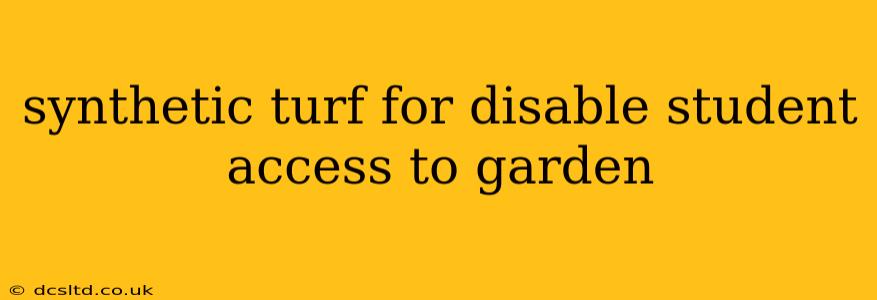Creating inclusive and accessible learning environments is paramount for all students, including those with disabilities. Gardens offer unique therapeutic and educational benefits, but traditional gardens can present significant barriers for students with mobility impairments or other disabilities. Synthetic turf provides a viable solution, offering a safe, accessible, and engaging alternative to natural grass. This article explores the benefits of using synthetic turf in school gardens designed for disabled students, addressing common concerns and offering practical advice.
Why Choose Synthetic Turf for Disabled Student Access?
Synthetic turf, also known as artificial turf, offers numerous advantages in creating accessible garden spaces for disabled students. Its key benefits include:
-
Improved Accessibility: Synthetic turf provides a smooth, level surface, eliminating uneven terrain and potential tripping hazards often found in natural grass gardens. This is crucial for students using wheelchairs, walkers, or other mobility aids. The consistent surface minimizes the risk of falls and injuries.
-
Reduced Maintenance: Unlike natural grass, synthetic turf requires minimal maintenance. There's no need for mowing, watering, fertilizing, or weeding, freeing up valuable time and resources for educational activities. This is especially beneficial for schools with limited staff or budget.
-
Enhanced Drainage: Properly installed synthetic turf systems boast excellent drainage, preventing waterlogging and mud which can pose significant accessibility challenges. Students using wheelchairs or other mobility devices can navigate the garden without getting stuck or encountering slippery surfaces.
-
All-Weather Use: Synthetic turf can withstand various weather conditions, including rain and snow, ensuring the garden remains accessible throughout the year. This extends the opportunities for learning and therapeutic activities.
-
Increased Sensory Stimulation (with careful planning): While the uniform texture might seem limiting, careful planning can incorporate diverse sensory elements alongside the synthetic turf. Raised garden beds, textured paving stones, fragrant plants in containers, and water features can enhance the sensory experience.
What are the Considerations When Using Synthetic Turf in a Garden for Disabled Students?
While synthetic turf offers many advantages, several factors need careful consideration:
-
Material Selection: Choose high-quality, non-toxic turf specifically designed for playgrounds or other high-traffic areas. This ensures safety and durability. Look for certifications that guarantee the absence of harmful chemicals.
-
Proper Installation: Professional installation is vital to ensure a smooth, level surface and optimal drainage. Incorrect installation can negate many of the accessibility benefits.
-
Surface Temperature: Synthetic turf can get hot in direct sunlight. Consider providing shade structures or choosing a turf with a cooler surface temperature.
-
Cost: Synthetic turf can be more expensive upfront than natural grass, but the long-term cost savings in maintenance can outweigh the initial investment.
What are the Potential Downsides of Synthetic Turf in a School Garden?
While generally beneficial, it's important to acknowledge potential drawbacks:
- Initial Cost: As mentioned, the upfront cost is a significant factor. Careful budgeting and grant applications might be necessary.
- Environmental Concerns: Some concerns exist regarding the environmental impact of synthetic turf production and disposal. Choose environmentally friendly options whenever possible, and consider options for recycling or responsible disposal at the end of the turf's lifespan.
- Aesthetic Considerations: Some might find the appearance of synthetic turf less natural than real grass. However, careful planning and landscaping can mitigate this concern.
How Can I Make Sure the Synthetic Turf Garden is Inclusive for All Disabilities?
Creating a truly inclusive garden requires considering the needs of students with various disabilities. This includes:
- Accessible pathways: Ensure wide, paved pathways with gentle slopes accommodate wheelchairs and other mobility devices.
- Raised garden beds: Allow students of all heights and mobility levels to participate in planting and tending to plants.
- Tactile elements: Incorporate textured surfaces, raised lettering, and other tactile elements for visually impaired students.
- Sensory considerations: Offer a variety of textures, scents, and sounds to engage multiple senses.
- Adaptive tools: Provide adaptive gardening tools to enable students with various physical limitations to participate fully.
Is Synthetic Turf the Right Choice for Every School Garden?
The suitability of synthetic turf depends on several factors, including budget, available space, and the specific needs of the disabled students. A thorough needs assessment involving students, teachers, and therapists is essential before making a decision.
By carefully considering these points, schools can effectively utilize synthetic turf to create accessible, engaging, and enriching garden spaces for all students, fostering a truly inclusive and supportive learning environment. The long-term benefits of increased accessibility and reduced maintenance often justify the initial investment, contributing significantly to a more equitable and beneficial educational experience for disabled students.
